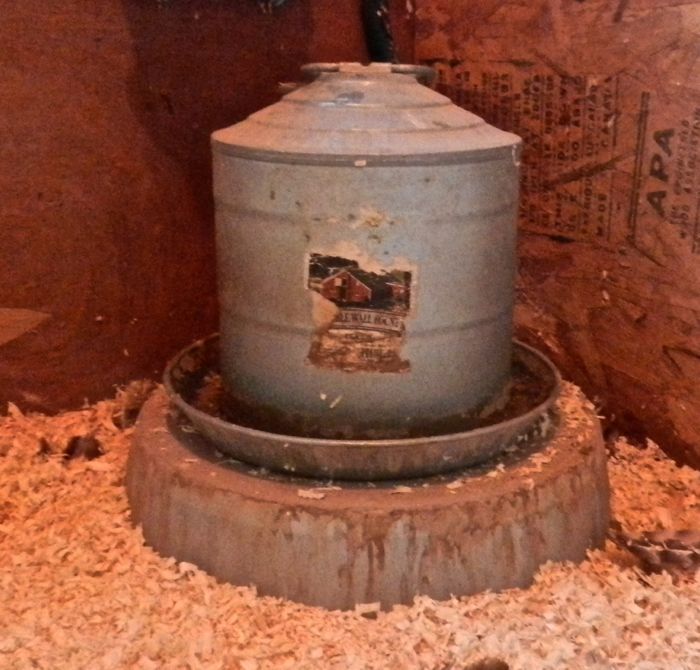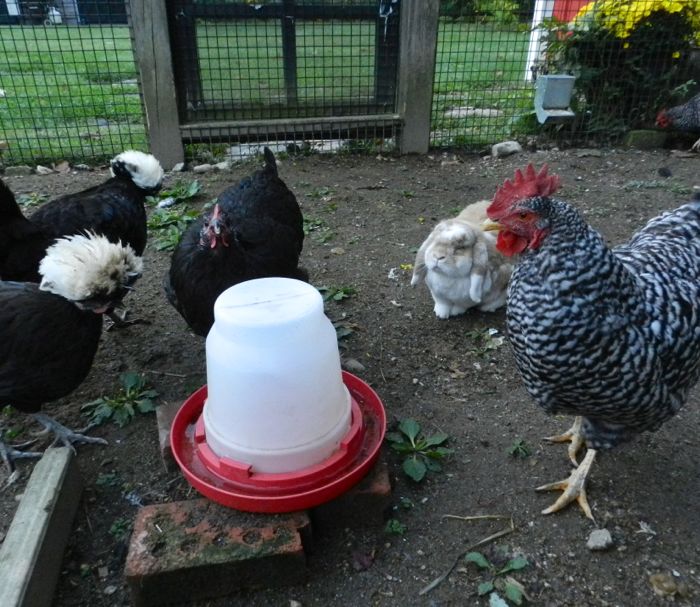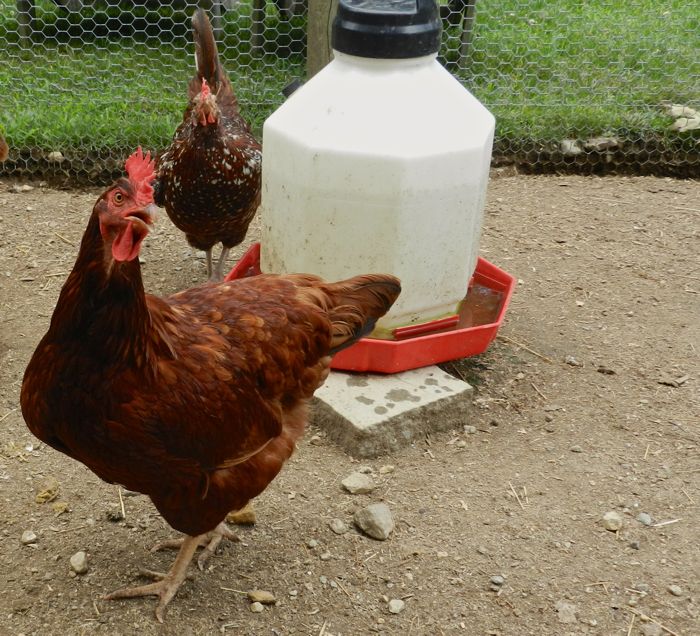Chickens love to eat. They’ll let you know that they are going to waste away if they aren’t fed right now and that an hour without a treat is a hardship. The truth is that they can go for days without food and recover just fine. What they can’t do without is water. Manure is 75% water. Egg whites are 90% water. Laying hens need to stay hydrated in order for their body processes to work. When it’s hot in the summer and the only water is in the sweltering coop, the hens won’t go inside to drink and they’ll suffer. It’s not only during times of high temperatures that you have to worry about keeping the waterers filled. Ignore the fount in the winter so that it freezes and assume they’ll be fine eating snow and your hens will be dead in two days.
I started out using plastic waterers, with the red screw-on bottoms. They’re fine for small flocks. But, they have their drawbacks. When almost empty the plastic dispenser is easy to tip over. The top is flat, so there’s always one bird that tries to roost on it. I don’t have running water in my barns in the winter, and so have to fill the waterer inside the house. Several times, carrying the plastic one out to the coop, the bottom popped off and splashed freezing cold water on me. I switched to the metal fount, which holds more water and is much easier to carry. Whichever type you use, you have to keep it from freezing solid. If you have electricity in the coop, use a heated base. For years my coop did not have power and so on the coldest of winter days I’d have to go out several times daily to swap frozen waterers for fresh. It is not enough to leave water early in the morning, and then replace the frozen dispenser with a fresh one at night. Chickens don’t drink after dark.
Even in the summer I keep the waterer raised up on the electric heater base (unplugged) to keep the water from getting bedding and manure in it. Notice that the electric cord is covered with a protective conduit. This is to keep Candy from chewing through the wire. But, a conduit is also a good idea in a barn that doesn’t have a rabbit, as mice gnaw wires and can potentially cause fires.
The above photo is a tad blurry because I took it early in the morning when the light wasn’t good. Notice that no one is drinking from this fount. That’s because they’re all outside drinking from this one:
Given their druthers, the girls prefer their water outside. I keep this fount filled until the temperature drops to freezing. Every few days it gets refilled. Even Candy likes drinking from it. Note that it’s up on bricks to keep it clean. An added bonus is that every once in awhile I move the base and the hens have a feast on worms that live underneath it.
The Big Barn houses the twelve large, young and active Gems. They, too, prefer to drink outside, but a small plastic waterer won’t do. This large one is awkward (and the gasket breaks) but it holds enough so that in the worst of the summer heat I only I have to refill it every four days or so. The Gems have a galvanized waterer inside of the coop, too, that I keep cleaned and filled.
Every time I fill a waterer, I take a scrub brush to it. Despite the fact that chickens love to drink from mucky mud puddles, I want the water that I give them to be clean! (The one in the photo is due to be cleaned and refilled.) Water dispensers, especially in the summer, are prone to hosting algae blooms. If that is a problem, a splash of apple cider vinegar in the fount keeps the water clear. (Only put vinegar in plastic containers as it will cause the metal ones to rust.) However, I don’t routinely add apple cider vinegar in a large enough quantity to be a tonic because I prefer to reserve it when needed medicinally.




I use the same combination of waterers as you – galvanized inside the coop and the large waterer you show in the run. An occasional touch of ACV in the outside waterer – sometimes as a treat, but usually medicinally – but NEVER in the galvanized steel. I learned the hard way that the fastest way to rust out an expensive waterer is to use apple cider vinegar in it. I use a heated base on inside in the winter, but outside, the plastic would freeze. So each morning and each afternoon, I run outside with a half gallon of warm water to refill a large flexible plastic dog bowl. If I’m at work, the kids do this for me. You would think the birds had won the lottery! They love the warm water on a cold day, and it keeps it from freezing for longer.
I always learn something new about chicken keeping from your posts. It’s certainly not a matter of throwing out some feed, water and then you just collect eggs for breakfast. Phew. Thanks for the tip about the apple cider vinegar. I’m constantly scrubbing my birdbath in the summer. Will try washing with a dash of apple cider vinegar next time. Someone claimed putting pennies in birdbaths kept the algae down, but I didn’t find that to be true.
I’d heard that about pennies, too. Thanks for doing the test so that I don’t have to :)
I refill the girls waterer every two days but soon I will be back to inventing ways for the water not to freeze whilst I’m at work all day! My coop is at the bottom of a 100 foot garden so I dont have electricity out there, I give them warm water during frosty/cold weather but nothing works. They have an Eglu Cube to sleep in (and have a covered shelter for colder days) but are out in the run all day. Sigh…….
Lucky me here in Texas for the past 3 years since I got my chickens it hasnt been cold enough in winter to freeze the water bowl during the day. Once in a while it will freeze overnight, but that is easily fixed when i let them out in the morning. I have found I prefer the plastic waterer to the metal, I bought metal first and it rusted out on me after only a year. The plastic one will last many years and I can add the vinegar to it if I want without worry. Love your Posts!
Thanks for reminding me to mention not to put vinegar in the metal dispensers. I’ll add that info to the post!
I change at least one of their three drinkers every day. I use the plastic ones with the green base, but I do replace them from time to time as they become difficult to get really clean. And occasionally they go through the dishwasher, too!
The last two days you have posted about two of the main things on my mind having to do with our hens! Love.
We have a plastic waterer in the run. Inside is a 5 gallon bucket ( heated) with chicken nipples attached. The hens we had before these young girls were totally fine with the nipple waterer. The current “princesses” don’t seem to like it. They run out every morning and drink from the plastic waterer in the run like they haven’t had a drink in daaaays. So dramatic. The inside waterer will be the only thing not frozen in the cold winter months so they need to get used to it. Can you tell I am looking for a little reassurance that they WILL drink from it? ha! ( we’ve shown it to them and they DO know it’s there)
Ah, our fussy chickens. Have you ever seen them actually drink from the nipple waterer? Betsy taught herself to drink from the rabbit’s bottle… while the rabbit hops down and drinks from the chicken’s plastic waterer.
I have one of those plastic waterers with the black screw off top like you have. I keep the gasket lubricated with a little bit of olive oil. It’s working so far, but I’m sure it will oxidize and break eventually.
This is off subject but have I witnessed a coup d’etat of the bunny throne by a couple of girls with big hair today?
Candy allows them in. If she wanted to, she’d kick them out. I think that the company amuses her.
Those fancy Polish chicks are the only ones I have ever seen in Candy’s hutch.
The only ones she allows.
I have a small backyard and limited choices where the run could go. Can I include my pond in the run? They could drink and cool off in it in the summer. I don’t have fish of plants in it. I use it mostly like a low bird bath. I drain the water and add fresh water. I have a pump in it that circulates the water. Is it a bad idea, possible drowning or dirty water? I have seen that people have hens and ducks together.
Chickens enjoy edges of ponds and puddles of water. My chickens free-range near my water feature and have never fallen in :) I’d worry more about my landscape than the hens. Hens will turn a small yard to packed dirt in no time. Some breeds are less destructive than other. Bantams don’t do as much damage. Feather-footed hens, like Cochins don’t either.
I have a comment off the subject also….Out of our 4 girls (23 weeks) only 2 are laying…we get a small one every day from one and have have 4 double yolk eggs from the other ( she just started laying last week and we only get one egg every other day from her) …??? Is that common or is it a fluke? I wish the others would start, everyones bugging us for eggs but we want to enjoy the few we’ve gotten ourselves!
Common!They’ll all start laying, (though not every day) and the double yolks will stop. You don’t have to share the eggs yet :)
Correct me if I am wrong Terry..but I also think the heavy breeds (Delawares, Orpingtons) take longer to lay? My big girls are the same age and no one has layed yet.
Correct – the heavier breeds do take longer to get started.
I’m happy with the eggs I’ve gotten….just mystyfied about my ella laying a bloody cracked egg…I’m scared….this is my first time having my girls, they’re my babies….
I was told I was giving my Ladies to much treats, that will keep them from laying, I should be giving them only their layer ration, so we’ll see.
Too much corn puts on fat that interferes with laying. I have a What to Feed Your Chickens FAQ.
Hi Terry..I have the waterers in the bottom picture…I have to change it every 2 days because the inside of the font turns green…it is a constant battle….the vinegar does help..especially in the heat….I use a baby bottle scrubber…it gets inside and under the rim.
One benefit of living in New England, for the last several nights the temp has dropped below 40 at night and algae doesn’t grow in the waterers! Of course, soon I’ll be breaking ice out of them…
I have a metal waterer inside the coop and two plastic ones outside. The girls seem to prefer the plastic ones. I don’t know if it is because they are outside or the water in the metal one has a different taste. Has anyone had this experience?
I also have the good fortune to have electricity in my coop (provided by a very clever friend) so I use a heated waterer in the winter. Next I’m hoping for running water;then I will be in heaven:)
I also have the same set up…1 metal inside the coop and 2 plastic waterers out of the coop. To me it seems they drink more from the plastic versus the metal.
I am trying to figure out now how to have water IN the new coop, and how to keep it from freezing. That warming base ($49 at TSC) says to only use a metal waterer on it, but I think you have the same one Terry, and you use the plastic one, right? Because of my parrots and zinc poisoning scares, I do not want to use galvanized metal. That’s just my bent.
Now in the temp coop dog pen I have a nice 3 inch deep crock sitting on a cement paver, which the ladies are tipping and spilling lately. (They have gotten SO BIG!) Inside the little night time coop I have one of those pvc rods with 2 cup waterers, connected to a big bucket which sits on top of the mini coop. I wasn’t sure they even knew how to wiggle the tab inside the cups to release the water, but once I came home late and the crock had been tipped and was completely dry. I felt inside the little cups in the mini coop and there was water in them, so somebody has firgured them out. Neither of these will do for winter, though. I just want to make sure they know where and how to get water.
I am a clean freak when it comes to birds’ water, so I am hoping to use the TSC heater and have 2 plastic shallow buckets (or maybe shallow crocks) so I can come outside in the winter with a clean one and just swap it for the dirty one, avoiding my own exposure to the cold. I’ve been searching for the right parts now for a few weeks.
For years I used the plastic waterers on the heater base even though the directions said not to. But, I take no responsibility if yours melt! No idea if the plastic has stayed the same over time.
You could get a vintage ceramic chicken waterer. I’ve seen them for not much more than the new metal ones.
Hmmm, I didn’t know they even existed. Thanks, I’ll look around. BTW I think that weed in your pumpkin patch is called ladysthumb. I have this desire to learn a few new weeds every year, and that one is so invasive in a wet area around my composter I just had to look it up.
There are also glass bases and waterers from the 1920s. Thanks for identifying the weed as ladysthumb. Its everywhere and even the goats don’t like to eat it.
Terry-
Am getting prepared for the winter soon to come here in Colorado. What kind of water heater is that in your pic? Where did you buy it from?? Thank you,
T.
The base is sold at the local feedstore, but you can also find online, like here.
I haven’t seen Betsy for quite awhile now. Is she okay? Maybe I just haven’t been watching at times when she’s on camera.
She is broody and is in the lefthand nesting box, hunkered down so you can’t see her. She’s too old for a long broody spell like this and is getting too skinny, so I’m going to have to break the broodiness this week.
Oh, good! Just saw her out in the hen yard looking very perky.
I use a heated dog water dish in the winter when it is really cold (Pennsylvania) also use the black rubber feed tubs for water , you can turn them over and give them a good kick and the frozen water will pop out! I was always told if your water bucket was not clean enough for you to drink out of, then it is not suitable for your animals…
Those black rubber tubs are great, but don’t your chickens perch on the rims?